The terms “orchestra” and “symphony” are often used interchangeably, leading to confusion about their distinct meanings. However, they represent different facets of the intricate world of classical music. In this article, we will demystify the differences between an orchestra and a symphony, exploring their unique roles, structures, and contributions to the rich tapestry of musical expression.
1. The Orchestra:
An orchestra is a large ensemble of musicians who play various instruments, organized into sections based on instrument families. These sections typically include strings (violins, violas, cellos, and double basses), woodwinds (flutes, oboes, clarinets, and bassoons), brass (trumpets, horns, trombones, and tubas), and percussion (drums, timpani, and other percussion instruments). Orchestras perform a diverse repertoire, including symphonies, concertos, overtures, and other classical compositions. They often accompany operas, ballets, and choral works, enhancing the overall musical experience.
2. The Symphony:
A symphony, on the other hand, is a specific form of musical composition. It is a substantial work for orchestra, usually consisting of multiple movements. Symphonies are typically instrumental pieces, showcasing the interplay of different sections within the orchestra. Composers like Beethoven, Mozart, and Brahms are renowned for their symphonic compositions, creating masterpieces that explore themes, emotions, and musical motifs across several movements. Each movement within a symphony has its unique character and contributes to the overall narrative of the composition.
3. Distinguishing Features:
The key difference lies in their nature and purpose. An orchestra refers to the ensemble of musicians, while a symphony refers to a specific genre of musical composition. Orchestras perform a wide range of musical works, not limited to symphonies, including concertos, chamber music, and contemporary compositions. Symphonies, on the other hand, are compositions specifically structured as multi-movement works for orchestras.
4. Evolution and Influence:
The symphonic form has evolved over centuries, with composers experimenting with different structures, styles, and thematic materials. While symphonies were a prominent genre in the Classical and Romantic eras, they continue to inspire contemporary composers, leading to the creation of modern symphonic works that blend traditional elements with innovative approaches.
Conclusion
In summary, an orchestra is a collective of musicians playing a variety of instruments, whereas a symphony is a carefully crafted musical composition for orchestras, structured with multiple movements. Orchestras serve as the vibrant canvas upon which symphonies and other musical compositions are brought to life, showcasing the collective artistry of musicians working in harmony. Both entities contribute uniquely to the world of classical music, enriching our cultural heritage and offering audiences a profound and immersive musical experience. Understanding the distinctions between orchestra and symphony enhances our appreciation of the complexity and beauty inherent in the realm of classical music.


